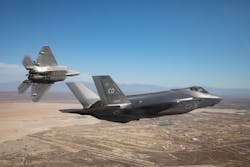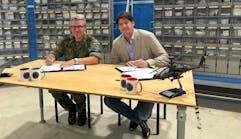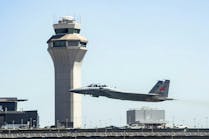AFMC Innovation Team Revolutionizes Stealth Fighter Fleet
412th Test Wing Public Affairs
An F-35A Lightning II from the 461st Flight Test Squadron recently took flight with a complement of software applications developed by government and industry providers previously tested on the F-22 Raptor – demonstrating for the first time the ability to use the same tactical software applications on both stealth fighters.
That success was immediately followed by another milestone when those applications were updated by software developers at Hill Air Force Base, Utah and flown at Edwards AFB less than 24 hours later.
These F-35 flights were the latest successes of an innovation project developed by a team of Edwards AFB’s test pilots, software developers from the 309th Software Engineering Group and the Air Combat Command Federal Laboratory. This project has now accomplished three key advancements that team members call game-changers for the future of the stealth-fighter fleet, and potentially all Defense Department aircraft.
These innovations are the ability to use the same software across different military aircraft; the ability to source that software from a diverse set of suppliers including software industry leaders and government labs; and the ability to update that software in less than a day, 30-60 times faster than previously possible. Together these improvements are poised to deliver cutting-edge technology to the stealth fighter fleet at a fraction of the current time and cost, team members said.
Historically, military aircraft have relied solely on the aircraft manufacturer to perform software upgrades or modifications, with limited ability to integrate software from external vendors. Additionally, because of the integrated nature of stealth aircraft software, development and implementation of software changes have previously required a lengthy process, limiting front-line aircraft to annual software updates regardless of operational developments and requirements.
In short, each aircraft required a unique development and testing process, driving up costs and delaying implementation.
To change this dynamic, the team partnered to develop and implement a government-owned and -controlled “app store” for these fighters. This was accomplished by combining government-owned software architecture with advanced processing onboard these aircraft and setting up a government software space for new tactical software. The team is now working to populate this space with the advanced capabilities these fighters need to maintain their dominance in the skies.
“The ability to use common software across the F-35 and F-22 is going to dramatically change how we bring capabilities to the front line,” said Lt. Col. Raven LeClair, project co-founder and F-35 test pilot. “Now, instead of having to define, purchase, test and field a software capability on each aircraft individually, we can gain a lot of efficiencies by developing a capability once and fielding it on all 5th gen fighters, saving hundreds of millions of dollars, if not more, in development costs and saving years in development time.”
The team also highlighted the benefits brought by access to a larger pool of software providers.
“There has been a lot of attention on how the military can harness the best contributions from government, industry and academia to maintain its edge, but there have historically been sizable barriers to entry into the defense market,” said Maj. Allen Black, project co-founder and F-22 test pilot. “This has been especially true with aircraft software since only the aircraft’s manufacturer could develop and integrate software onto the aircraft. They produce a fantastic product but being able to add to that baseline with capabilities created by software leaders in fields like AI/autonomy and cybersecurity will be transformative. This has the added benefit of increasing the number of companies and personnel working to modernize and enhance our combat aircraft fleet, resulting in higher throughput and faster progress modernizing our aircraft.”
While emphasizing the significant benefits of cross-platform compatibility and a more open market for software, the team is quick to point out that speed of delivery is perhaps the most vital.
“The National Defense Strategy identifies the need to rapidly experiment and then streamline acquisitions to get capabilities out to the warfighter on strategically relevant timelines,” said Maj. Cameron Jones, F-22 test pilot and part of the founding team. “It is vital that we are able to rapidly develop and deliver capability, because the best software in the world won’t make a difference if it’s late to the fight.”
The team has taken up that mission and is working to establish that ability on existing weapon systems that weren’t originally built to accommodate the modern pace of software innovation.
“This project allows us to load new software and update existing software, separate from the safety of flight systems of the aircraft, so we can make changes in a matter of hours instead of months,” Jones said. “This capability means that developers will be able to make quick changes based off pilot feedback, dramatically shortening the time to get a fieldable product.”
“This project helps to set the foundation required for agile combat employment,” said Marine Corps Maj. Kyle McLeod, the project’s lead F-35 test pilot. “We need to be able to rapidly adapt and update our weapon systems based on emerging intel or changing conditions while executing distributed operations. We demonstrated just that with this test. We flew a set of applications at Edwards, updated the simulated threat dataset in the software from the development location at Hill AFB, and re-flew the software in less than 24 hours.”
One of the team’s top priorities has been to leverage this new technology to help secure these aircraft from cyberattacks, said Omar Morales, 309th SWEG F-35 Lightning II lead software engineer.
“In addition to ensuring cyber best practices in the software development pipeline, we’re also using this new software environment to add cyber protection tools from leaders in industry,” Morales said. “Our test included cybersecurity applications that we are evaluating that can monitor the aircraft and identify anomalous behavior. We are working to leverage these types of products to allow us to identify and then fix potential cyber issues quickly, even between sorties, while also defending the aircraft in real time.”
Team members say this project’s benefits go beyond the improved software capabilities it brings to the aircraft. The project is proving to be a source of inspiration and motivation for those who joined the test world to make a difference.
“Working on this project has been incredibly fulfilling for our team, as our people genuinely believe they are making a difference for our nation,” said Jarron Lembke, 309th SWEG project team lead.
The idea was submitted to the Air Force’s annual Spark Tank competition, ultimately advancing to become a finalist where it was pitched to the senior leaders of the Air Force including the Air Force Chief of Staff Gen. CQ Brown, Jr. and former Chief of Space Operations Gen. John "Jay" Raymond. The project is now part of the of the Air Force vice chief of staff's Innovation Portfolio and is continuing to revolutionize software development and fielding, including ongoing work on software to control unmanned wingmen.



